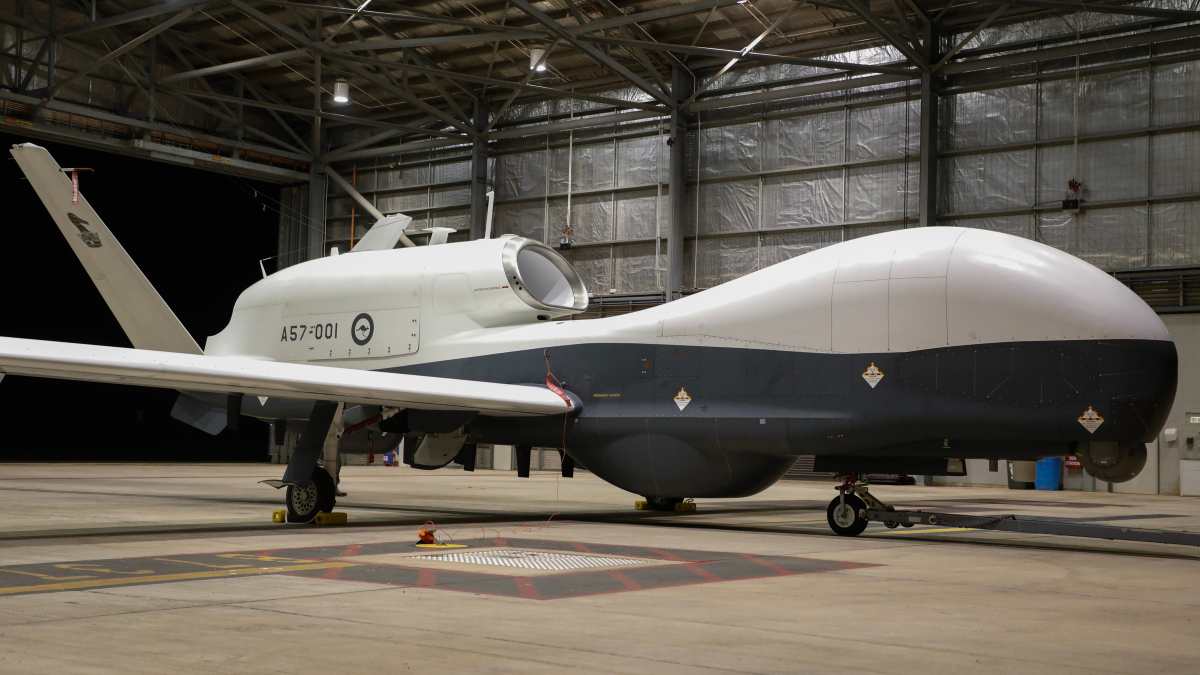The Triton’s modern payloads and increased endurance will allow Australia to patrol its north, north-western approaches, south-west Pacific and south to Antarctica.
The first of at least four large Northrop Grumman MQ-4C Triton High-Altitude Long-Endurance maritime reconnaissance UAV for the RAAF (Royal Australian Air Force) arrived at the country’s Tindal air base before dawn on Jun. 16, 2024. Dubbed AUS 1, the drone departed Point Mugu Naval Air Station near Los Angeles, California, and made the trans-Pacific delivery flight via Wake Island to RAAF Tindal in Australia’s Northern Territory.
Pictures released by Australia’s Department of Defence show the Triton, bearing the serial number ‘A57-001’ landing at the air base in dark hours, before being moved into a hangar. The UAV’s arrival was preceded by an initial flight test campaign at Palmdale in California, and four months of testing and final fit-out at the U.S. Navy’s Naval Air Station at Patuxent River in Maryland. On Jun. 7, the aircraft was then ferried to Point Mugu to prepare for the long journey flight to Australia.
The Triton has gained particular importance in Allied perpetual aerial ISR (Intelligence, Surveillance and Reconnaissance) missions both over Europe monitoring Russia, and the Indo-Pacific theater monitoring China. In April, the U.S. Navy announced the arrival of the first MQ-4C Triton at Naval Air Station Sigonella, Italy.
Assigned to Unmanned Patrol Squadron (VUP) 19 “Big Red”, homeported in Florida, this was the second forward deployment for the squadron. The first one took place at Andersen Air Force Base on Guam in the western Pacific. Japan’s Kadena Air Base in Okinawa received another MQ-4C Triton on Jun. 9, the Okinawa Times reported, after the first aircraft arrived there on May 20.

Australia’s need for ‘persistent aerial surveillance’
According to ABC news, Australia first expressed interest in acquiring the Triton “more than 20 years ago.” Ahead of the arrival of Australia’s first MQ-4C, the head of Air Force Capability, Air Vice-Marshal Wendy Blyth, said RAAF pilots and crews had already been busy training on the platform in the United States.
“These personnel received the same training as their USN counterparts and gained valuable experience to ensure that the Air Force is able to deploy the MQ-4C Triton effectively,” she said.
The Triton is based on the RQ-4B Global Hawk flown by the U.S. Air Force and it also augments the capabilities of the P-8 Poseidon maritime patrol aircraft. Its sensors are based upon components of systems (or entire systems) already fielded in the DoD inventory, according to NAVAIR (Naval Air Systems Command).
Also known as Broad Area Maritime Surveillance (BAMS), the MQ-4C gathers and processes surveillance information, fusing and networking sensor data from multiple aircraft into a coherent picture of the battlespace. It has been claimed to have an endurance of at least 24 hours, with some assessments believing it to reach 30 hours.
The Australian Department of Defense said, prior to the Triton’s arrival, that the remotely piloted aircraft had completed the first leg of its “ferrying flight” on Feb. 16. Blyth also specified Australia’s “north, north-western approaches, south-west Pacific and south to Antarctica,” as the areas in the “maritime domain” for its “ISR tasks” by exploiting the Triton’s “modern payloads and increased endurance.”
Australia had prepared for the AUS 1’s arrival by setting up the ‘trailerised’ Forward Operating Base (FOB) in January, which is the initial ground Mission Control Station for the MQ-4C Triton. This was stated by Group Captain Andrew Leahy, Director – Future ISR Program Office in Capability Acquisition and Sustainment Group (CASG) in the Australian Defence Department statement. “These [will be] in support of the additional aircraft that will be delivered to complete the RAAF MQ-4C Triton fleet,” Leahy added.

Permanent ‘eye in the sky’
As mentioned earlier, based on the RQ-4B Global Hawk flown by the US Air Force, Japan and NATO, the Triton has been optimized for maritime reconnaissance roles.
The modifications include a strengthened airframe, de-icing on the wings and engine inlet, a powerful radar, maritime modes for the MTS-B electro-optical sensor, and a comprehensive MULTI-INT system able to listen to and classify adversary electronic emissions.
With additional Triton units, Australian military planners can undertake rotational aerial surveillance as permanent eyes in the sky, keeping a watch on PLA Navy maneuvers in the western and southern Pacific. Data sharing between the Australian Tritons and the ones operated by the US military in Japan in the ECS (East China Sea) could improve even more the intelligence ‘picture’ of the area.
BTW, we have recently covered U.S. Navy MQ-4C’s operations in 6th Fleet AOR (Area Of Responsibility), and in particular around North Africa and Black Sea here.














